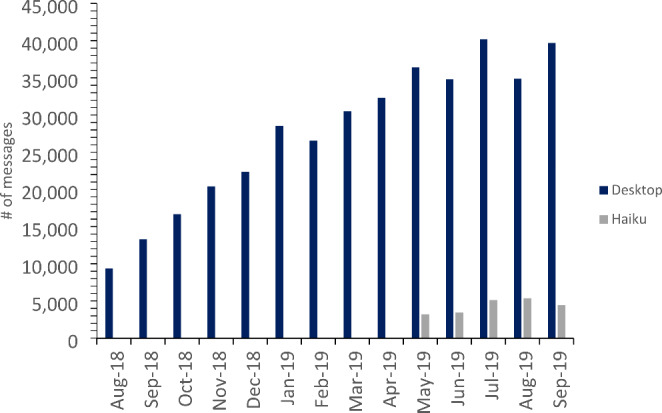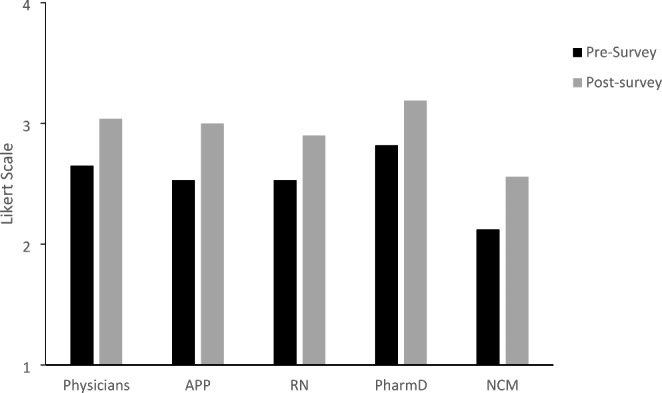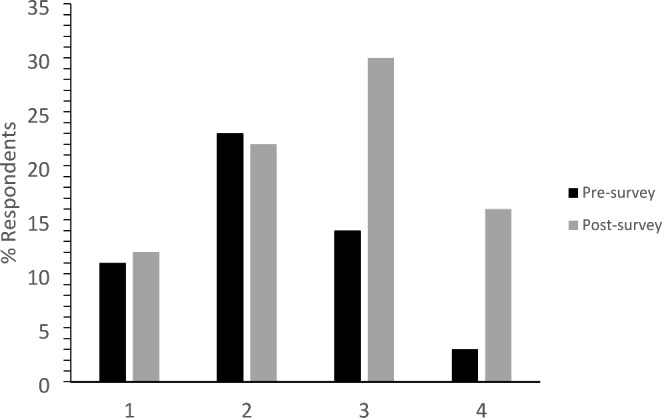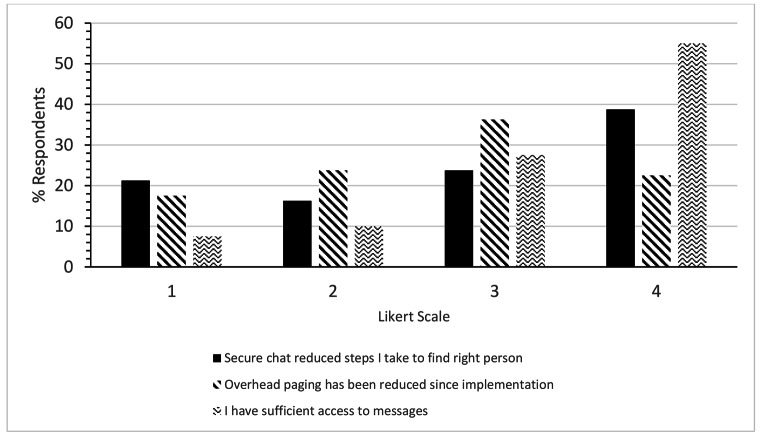Abstract
Given the complexities of communication within health systems, we investigated how the implementation of secure messaging in addition to traditional paging would impact hospital communication. This study was implemented at Grady Health System (GHS), a large safety net academic hospital system in metro Atlanta that includes inpatient and ambulatory settings. GHS uses Epic Electronic Health Record (EHR), and secure messaging was performed using Epic Haiku Platform. To assess states of communication, we implemented pre- and post-surveys. The secure messaging data tracked from 2018 to 2022 demonstrated a rise in usage from 9,378 chats per month when it went live in August 2018 to greater than 200,000 monthly messages during the pandemic when social distancing measures were enacted. Monthly usage peaked in March 2022 with 378,932 messages. Pre-and-post survey questions using a Likert scale (1–4) showed increased agreement in the ability to reach all team members through secure chat amongst healthcare workers. Within our unit staff, communication improved by being more rapid and reliable, as the Likert scale means increased from 2.18 pre-survey to 2.63 post survey. Pre-and-post survey analysis indicates improved satisfaction across GHS stakeholders with the implementation of secure chat in addition to the existing direct-paging system. Next steps could include exchanging digital media through secure messaging to facilitate faster diagnosis and treatment of certain medical conditions. Secure messaging integrated within the EHR (including mobile devices) enhances communication between healthcare team members in a HIPAA-compliant way reducing the number of pages and phone calls.
Keywords: Communication, Secure Messaging, Chat, Electronic Health Record (EHR), Paging
Introduction
Communication within the medical field is critical to ensure safe, timely delivery of healthcare. Transitioning from one-way pagers to two-way secure messaging platforms that are HIPAA complaint has alleviated inefficiencies such as transmission errors and promoted closed-loop communication. Currently, two main types of communication formats exist. The first focuses on secure communication within existing clinical applications and operating systems, indexing on functionality as a means of improving communication. The second type is seen as a clinical communication and collaboration (CC&C) platform that prioritizes operational integration that can be customized to a variety of health systems [1]. The overarching goal of both is to amplify functional engagement between healthcare staff and patients through faster, more accountable messaging response times, and upholding patient privacy while seamlessly integrating within the hospital clinical infrastructure to advance health outcomes. Furthermore, the coronavirus pandemic accelerated the adoption of remote communication for healthcare workers given the social distancing measures put in place.
Literature review suggests that the transition from pagers to secure messaging platforms is relatively new. Pagers, introduced in the mid 20th century, became increasingly popular in the 1980-1990 s. Paging technology was soon usurped by the advent of mobile phones, which allowed for two-way short message service (SMS) communication. This method of communication, also known as text messaging, has become deeply embedded within clinical infrastructure. Figures indicate that 85% of healthcare staff have access to smartphones, and about 60–80% of this clinical staff use text messages to discuss patient care [2]. The benefits of text messaging are self-evident: ease of use, efficiency, seamless workflow integration. However, as the concern for patient privacy remains paramount given that text messaging does not use encryption technology, there has been a transition towards using HIPAA-compatible secure messaging platforms.
A survey conducted in 2017 using the Society of Hospital Medicine database indicated about 26.6% of respondents’ organizations had employed a secure messaging platform [2]. As its adoption has accelerated, more studies have come out and enumerated their benefits. In 2014, an eight-week prospective, cluster-randomized, controlled trial was conducted with inpatient medicine teams at Stanford Hospital to assess the benefits of secure messaging. They found that it was perceived to improve hospital communication amongst clinical staff through its efficiency, workflow integration, and user experience satisfaction [3]. In 2018, a literature review was conducted investigating the relationship between smartphone-based messaging and streamlining patient care within Emergency Departments nationwide. This study feels intuitive, as Emergency Departments are constantly overseeing high-volume patient care. They place a premium on optimal patient throughput and disposition. As such, smartphone-based messaging was shown to limit fragmented conversations amongst providers and expedite clinical decision making. Some examples included rapid EKG interpretation via messaging resulting in faster catheterization laboratory activation times and shorter door-to-balloon times, as well as faster transmission times for radiology reads and laboratory results [4]. In 2019, a Radiation Oncology group implemented a secure mobile messaging platform in the outpatient setting to address gaps in care communication. They then surveyed this clinical team who verbalized an increased satisfaction with the timeliness and quality of communication within the department. Furthermore, they emphasized how these improvements boosted the morale of the clinical staff while working in an emotionally demanding arena such as oncology [5].
While there have been studies surrounding exclusive utilization of electronic paging or secure messaging, one study of import conducted by researchers at Cincinnati Children’s Hospital Medical Center (CCHMC) examined the impact of adding a new secure messaging platform to an existing, unidirectional alphanumeric electronic paging system. They collected pager data before implementation, and both pager and secure messaging data afterwards, to analyze whether secure messaging would reduce communication failures and adverse medical events. Results indicated a median daily potential communication failure rate reduction from 5.5 to 2.2% with the addition of secure messaging to the existing electronic paging system, a 59% decrease in potential paging communication failures as measured through manual review of messaging data capturing broken communication loops [6]. By avoiding errors in communication, secure messaging can foster better health outcomes. A report conducted at Carnegie Mellon University investigating Pennsylvania hospital health outcomes state-wide echoed this sentiment, citing hospitals that use secure messaging see significant reductions in medical errors and patient safety incidents [7].
Grady Health System
As our institution’s patient-centered vision for health equity and advancement aligns with the benefits of secure messaging, we introduced a secure “chat” feature on the Epic EHR at Grady Health System, one of the largest urban academic hospitals in the nation. This secure messaging application was an addition to the existing communication infrastructure, a classic one-way paging system between hospital nursing staff, advanced practitioners, and physicians. The relevant physician stakeholders at GHS include faculty and residents from two Medical Schools: Emory University School of Medicine and Morehouse University School of Medicine. It was logical to weave a secure messaging platform into our Epic EHR infrastructure given that it already existed as the primary hospital operating system. As mentioned earlier, this addition would fall into the first main format of hospital communication that focuses on improving communication through enhanced functionality.
The literature review suggests that most studies on hospital communication were conducted before 2020 and primarily investigated exclusive use of electronic paging or secure messaging. In this paper, we further the conversation regarding hospital communication by providing an updated analysis on the simultaneous implementation and use of secure chat within the existing Epic EHR platform in addition to electronic paging as a dual method of correspondence between healthcare staff at a large volume hospital. We also discuss the possible benefits of harnessing digital health media via secure chat and integrating this into the clinical decision-making workflow, hoping to propel the narrative that fully integrated secure messaging is essential for contemporary, progressive clinical care.
COVID Pandemic Impacts
The coronavirus pandemic compelled healthcare to rethink how to best serve patients while maintaining the mental and physical well-being of its clinicians. The pressure of surging patient loads necessitated that both physical and digital health infrastructure be flexible and adaptable. With regards to the latter, remote communication between healthcare workers was adopted at a rapid rate given the social distancing measures that became commonplace during the pandemic. We examined this concept by looking at how usage rates of secure chat messaging increased at Grady Memorial Hospital as the pandemic progressed.
Materials and Methods
Grady Health System (GHS) is a large organization as discussed above and is considered an Americas Essential Hospital (AEH) caring for an underserved population consisting of mostly Medicare/Medicaid and self-pay patient population. Our patients are disproportionately affected by social determinants of health. The hospital system on average has a daily census around 650 bed occupancy. Both Morehouse and Emory utilize different systems for paging which can generate challenges around communication between various staff members. Of note, GHS only had traditional paging and did not have secure messaging prior to our implementation of secure chat through Epic.
Before we officially went live with secure messaging in August 2018, we operated on version 2018 of Epic. The version of secure chat that we used for our go-live was the 2019 version of Epic. Because of the multiple entities, the first part of this project was to develop guidelines on what would be appropriate to include in a secure chat message. Our informatics team (consisting of physicians, nurses, IT leadership, and medical leadership) developed a best-practice framework. It was determined that secure chat should be used for brief, non-emergent messages. Specific criteria on when not to use secure chat included the following: to communicate critical information about a patient, to communicate urgent or critical results, texting information related to peer review or quality assurance. The second part of the project was to decide if the secure messages would become a legal part of patient medical records. After much deliberation with legal and risk management, the decision was made to forgo this inclusion and purse the messages every 72 h from the system. The third part of the project was to establish the inclusion of clinicians in secure chats that accurately reflected the active healthcare providers for patients daily. As such, clinicians were allowed the flexibility to add or remove themselves from any secure group chat and given the freedom to assign someone to provide coverage for them if they were away (vacation) or not available (operating room) or simply change their setting as “not available”. Furthermore, there were no restrictions to who could receive messages if they had Haiku or access to secure Wi-Fi to log into Epic.
Prior to implementation, a pre-assessment survey was performed to estimate the qualitative assessment around communication. We also performed a post-implementation survey to see any changes one year later. The survey consisted of questions using a Likert scale on various aspects of communication between different team members and communication within the health system. We used a scale of 1–4 with 1 representing “completely disagree” and 4 representing “completely agree”.
There was an emphasis placed on educating and training the GHS house staff on the new secure messaging system. We disseminated education of the secure chat feature and guidelines on usage to all staff via sharing tip-sheets, sending an Epic “message of the day”, and presenting these new guidelines at departmental service meetings and resident orientation sessions prior to the roll-out of the new messaging system. All new hires, including clinicians, were provided these training resources as a part of their on-boarding. In May of 2019, GHS went live with Haiku which is the Epic mobile app and secure messaging was available via Haiku. When this went live, we provided education like above.
We tracked the number of secure chat messages by provider type (e.g., physician, nurse, pharmacy, etc.), as well as use of secure chat via a desktop and mobile device. The data were tracked by month from 2018 to 2022.
Results
Usage of Secure Chat
Over the first year of secure chat, we tracked which disciplines were using secure chat and the number of messages sent via desktop and mobile devices. During the first year of implementation, about 33% of usage was by physicians (including residents, fellows, faculty), 22% by nurses, 10% by pharmacists, 6% by advanced practitioners, 4% by social workers and case managers, followed by a smaller percentage of Certified Medical Assistants (CMA) and other team members. Figure 1 shows the number of messages from August 2018–2019 on desktops and on Haiku.
Fig. 1.

A graph showing the number of messages via desktop and Haiku from implementation in 2018 to 2019. Note: Haiku became available starting May 2019
Survey Results
In 2018 prior to the launch of secure chat, we conducted a pre-assessment survey as described in the methods section. From the health system, 50 respondents completed the survey which included a variety of disciplines (physicians including residents and faculty, nurses, pharmacists, social workers, case managers, etc.) across different settings in the hospital (ambulatory, radiology, inpatient, emergency department). In 2019, we conducted a similar post-assessment survey to assess how secure chat was functioning and any qualitative changes around improvements in communication. This was completed by 80 staff members; again, it was diverse and multidisciplinary. These pre-and-post survey questions used a Likert scale (1–4) to highlight the degree of agreement on the survey statements, with scores of 1 indicating complete disagreement and 4 indicating complete agreement.
There were several questions pertaining to the ability to reach certain team members including physicians, APPs, nurses, pharmacists, and case managers. We found that over the year of implementing secure chat, there was an increase in the mean for agreement with the statement “ability to reach (provider type) on my unit” within each category of healthcare team member shown in Fig. 2.
Fig. 2.

Comparison of mean pre- and post- assessment for the ability to reach different healthcare workers. The Likert scale is the degree of agreement (1- completely disagree and 1- completely agree)
We also asked the question of whether our health system has a reliable means of communication within our unit staff. We found an upward trend towards agreement in the post-survey after implementation of secure chat, as evidenced by the Likert scale mean increasing from 2.18 in the pre-survey to 2.63 in the post survey. These data are shown in Fig. 3.
Fig. 3.

Pre- and post- survey assessment of whether we have rapid and reliable means of communication within our unit staff. The mean for the pre-survey was 2.18 and for the post-survey it was 2.63. The Likert scale is the degree of agreement (1- completely disagree and 4- completely agree)
We also asked unique questions in the post-survey around secure chat function and access. We inquired whether secure chat reduced the number of steps it takes in the day to find the right person and if overhead paging was reduced since implantation of secure chat. The Likert scale responses to both statements indicated a trend towards agreement. We also looked at whether access of three days duration to secure chat was sufficient, finding that there was general agreement with this statement as well. The results are shown in Fig. 4.
Fig. 4.
This shows % respondents responding to three questions around implementation of secure chat with Likert scale on x-axis (1-complete disagreement and 4-ccomplete agreement). The black bars show results for “secure chat function has reduced the number of steps I take in the day to find the right person”, the blue shows result for “overhead paging has been reduced since implantation of secure chat”, and the red graph show results for “I have sufficient access to secure chat conversations for 3 days until conversations are reset”
COVID Pandemic and Secure Chat
Soon after we completed the post-survey, the COVID-19 pandemic followed and rapid changes in hospital policies ensued surrounding personnel in the hospital and isolation starting in March 2020. This afforded us the unique opportunity to evaluate the role of secure chat messaging and communication given these limitations and isolation especially early in the pandemic. As shown in Figure 5, there was a rapid increase in the use of secure chat over desktop as well as over Haiku from October 2019 to 2022 with some stabilization during 2022 as the restrictions and regulations around COVID-19 precautions loosened. Desktop secure messaging in October 2019 totaled 46,457 and peaked at 378,932 in March 2022. Haiku secure messaging in October 2019 totaled 5,125 and peaked at 28,153 in January 2022.
Fig. 5.
Secure chat messages by month from October 2019 to June 2022. (a) Desktop messages and (b) Haiku chat messages
Discussion
A comparison of the pre-and-post-surveys indicate that there was widespread satisfaction with secure chat across a diverse spectrum of different healthcare providers. This was a function of different team members improved ability to reach out and communicate with other members of the care team, as concluded through our statistically significant t-tests (Fig. 2). Furthermore, using secure chat as a reliable means of communicating was another noteworthy trend during our post-survey investigation (Fig. 3). Both findings made the daily workflow of physicians, APPs, nurses, pharmacists, and case managers more secure and seamless, as demonstrated by the ever-increasing number of messages being sent through secure chat interphase. This increased usage of secure messaging was most prominent when the coronavirus pandemic surged in the beginning of March 2020. As visualized in Fig. 5, the rate at which secure messages were sent on a monthly basis soared. This makes sense, as social distancing and barriers to traditional, in-person communication became commonplace during this time. By having secure chat as a mainstay of communication for over one-year at that point, it provided GHS staff with the flexibility to adapt to the new environment relatively quickly and take advantage of touchless communication in a safe and reliable fashion.
We anecdotally observed time-saving benefits from using secure chat based on feedback from nurses, pharmacy staff, and physicians alike. Given that a large majority of our patients’ health care is impacted by social determinants of health, many of the delays in workflow and turnaround time centered around obtaining appropriate social documentation for durable medical equipment (DME) and housing insecurity. Our clinicians and social care staff stated that secure messaging allowed for faster coordination and collaboration to complete this paperwork, reducing turnaround time, and accomplishing more timely discharges. Furthermore, pharmacists have stated that correcting medication doses and orders have become easier as they can confirm changes through secure messaging faster than previously when using traditional paging for the same purpose.
One point of emphasis is that secure messaging adds an additional layer of communication to the usual direct-paging style of communication; secure messaging is not a replacement. In that vein, an initial barrier to adoption was understanding when and where to use secure chat. As such, we indicated specific criteria of when not to use secure messaging and supported these efforts through continued education and distribution of these guidelines through tip-sheets, departmental meetings, and house staff orientations prior to and during the deployment of secure chat to encourage adoption acceleration. Although there has been steady improvement, there remains room for improvement. We continue to consistently encourage that users of secure chat to refrain from sending messages that include critical lab values, time-sensitive patient and clinical information, and quality assurance information.
One of the limitations of our study is the low participant count. However, our smaller sample size included a broad array of disciplines including clinical and social staff, validating the benefits of secure chat from a diverse perspective. The next iteration of secure chat is to incorporate digital media to aid in the diagnosis and treatment of illnesses that require visual evaluation. For example, the management of certain dermatologic and vascular illnesses and diseases can be optimized by sharing digital pictures through the HIPPA-complaint secure messaging interphase with the appropriate medical teams for faster response time and clinical guidance.
Conclusion
The implementation of secure messaging became essential for GHS to strengthen its clinical communication between healthcare providers. Given that the health system uses three separate paging systems, one for hospital staff and one for each medical school, secure messaging provided a standardized and dependable mode of communication where providers hospital-wide could connect easily with each other in real-time.
Secure messaging was successful in providing a rapid, reliable means of communication between interdisciplinary health staff in a safe, secure manner. This was evidenced through the pre-and-post surveys that highlighted the functionality and utility of secure messaging as key components in achieving this goal. The gross utilization of secure messaging, as measured by number of messages sent per month, increased exponentially from the implementation through today. This high adoption rate was driven, in part, by the arrival of COVID-19 and social distancing. The pandemic pushed the healthcare community to rethink and evolve what communication could look like in the face of the obstacles that COVID-19 presented. Given that integrating secure messaging at Grady Memorial Hospital was a successful endeavor, next steps include re-emphasizing the importance of what should and should not be included through direct messaging via secure chat (i.e., critical lab values) as well as conveying digital media through this medium between clinicians.
Acknowledgements
None.
Author Contribution
All authors contributed in preparation of the manuscript.
Funding
There was no funding received for this research.
Data Availability
The data underlying this article will be shared on reasonable request by the corresponding author.
Declarations
Ethics approval
Not applicable.
Competing interests
The authors have no competing interests to declare that are relevant to the content of this article.
Footnotes
Publisher’s Note
Springer Nature remains neutral with regard to jurisdictional claims in published maps and institutional affiliations.
Contributor Information
Suvrat Chandra, Email: schandra@msm.edu.
Mindy Oberg, Email: mmoberg@gmh.edu.
Glenn Hilburn, Email: ghilburn@gmh.edu.
Daniel T. Wu, Email: dtwu@emory.edu
Bhavin B. Adhyaru, Email: badhyar@emory.edu
References
- 1.Freundlich RE, Freundlich KL, Drolet BC. Pagers, Smartphones, and HIPAA: Finding the Best Solution for Electronic Communication of Protected Health Information. J Med Syst. 2017;42(1):9. doi: 10.1007/s10916-017-0870-9. [DOI] [PubMed] [Google Scholar]
- 2.Liu X, Sutton PR, McKenna R, et al. Evaluation of Secure Messaging Applications for a Health Care System: A Case Study. Appl Clin Inform. 2019;10(1):140–50. doi: 10.1055/s-0039-1678607. [DOI] [PMC free article] [PubMed] [Google Scholar]
- 3.Przybylo JA, Wang A, Loftus P, Evans KH, Chu I, Shieh L. Smarter hospital communication: secure smartphone text messaging improves provider satisfaction and perception of efficacy, workflow. J Hosp Med. 2014;9(9):573–8. doi: 10.1002/jhm.2228. [DOI] [PMC free article] [PubMed] [Google Scholar]
- 4.Pourmand A, Roberson J, Gallugi A, Sabha Y, O’Connell F. Secure smartphone application-based text messaging in emergency department, a system implementation and review of literature. Am J Emerg Med. 2018;36(9):1680–85. doi: 10.1016/j.ajem.2018.06.067. [DOI] [PubMed] [Google Scholar]
- 5.Arscott WT, Gray K, Kuska D, et al. Evaluating the Impact of Secure Mobile Messaging on Communication and Cancer Care Team Satisfaction in a Large Radiation Oncology Clinic. J Oncol Pract. 2019;15(8):e733-e38. doi: 10.1200/JOP.18.00539. [DOI] [PubMed] [Google Scholar]
- 6.Hansen JE, Lazow M, Hagedorn PA. Reducing Interdisciplinary Communication Failures Through Secure Text Messaging: A Quality Improvement Project. Pediatr Qual Saf. 2018;3(1):e053. doi: 10.1097/pq9.0000000000000053. [DOI] [PMC free article] [PubMed] [Google Scholar]
- 7.Muhammad Z H, Telang R, et al. Saving Patient Ryan-Can Advanced Electronic Medical Records Make Patient Care Safer? Management Science 2018;65(5):2041–59. 10.1287/MNSC.2018.3042
Associated Data
This section collects any data citations, data availability statements, or supplementary materials included in this article.
Data Availability Statement
The data underlying this article will be shared on reasonable request by the corresponding author.




